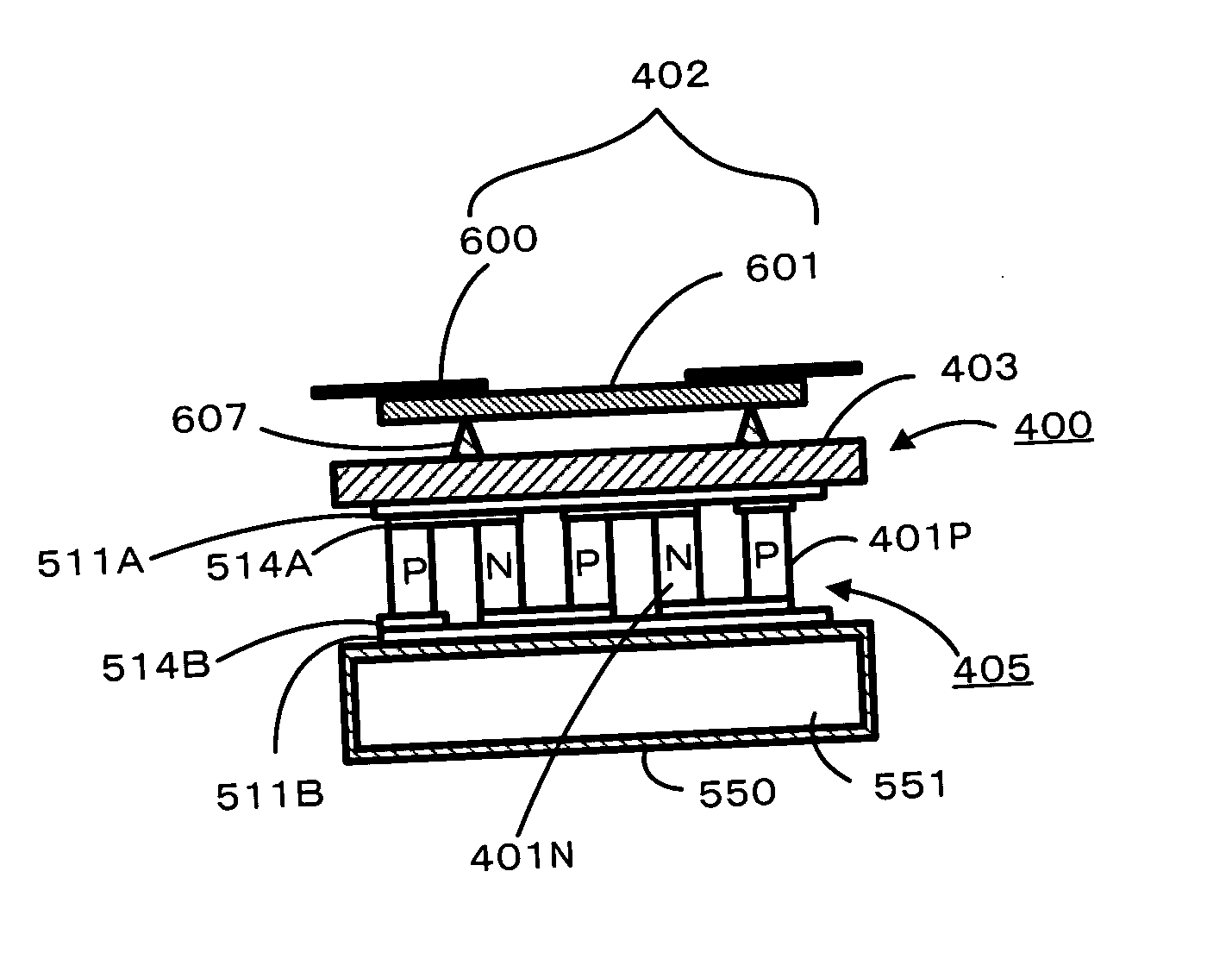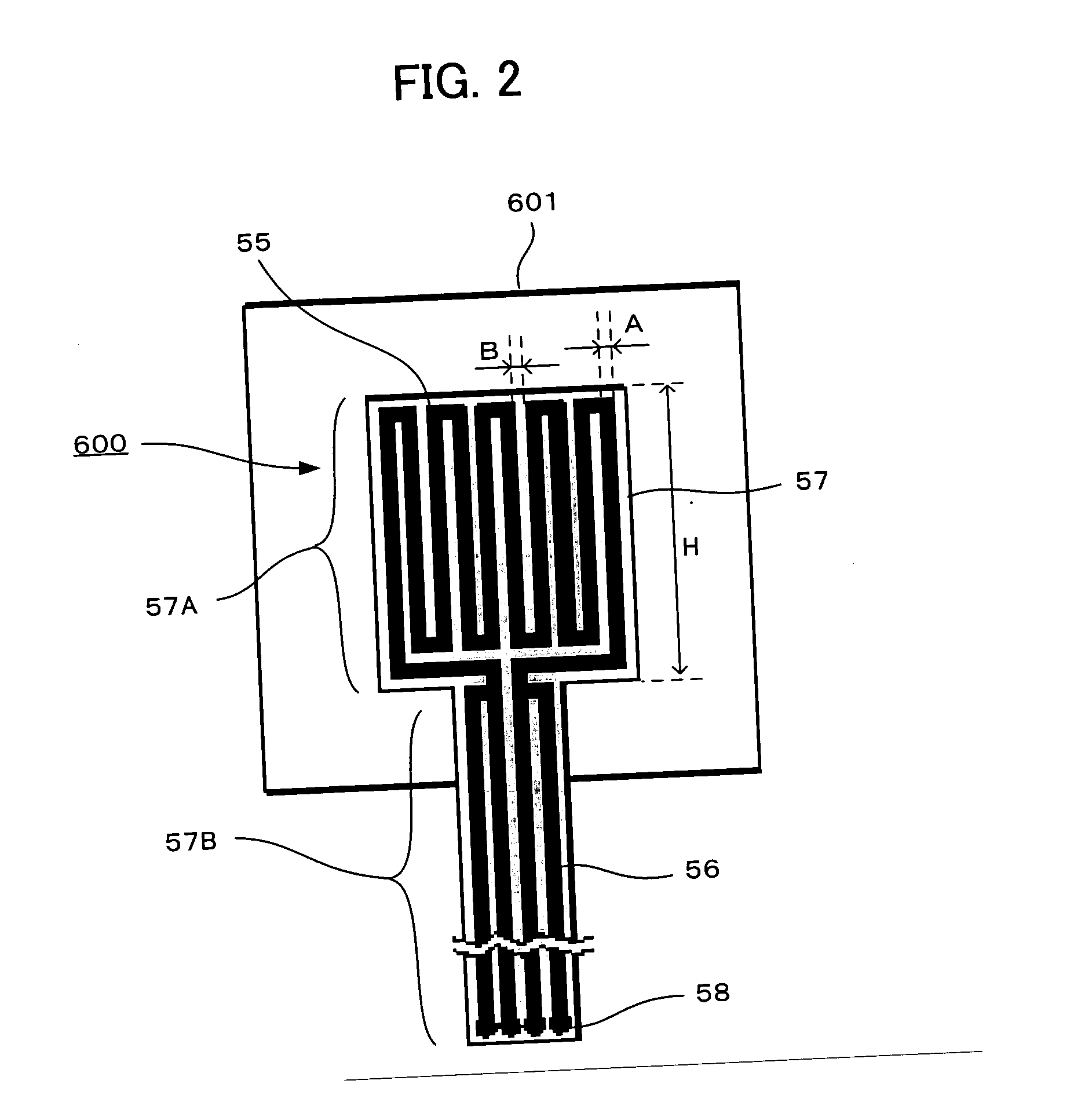Film temperature sensor and temperature sensing substrate
a temperature sensor and substrate technology, applied in the direction of positive temperature coefficient thermistors, instruments, heat measurement, etc., can solve the problems of affecting the temperature of the temperature sensing substrate and the deterioration of the cleanliness of the entire devi
- Summary
- Abstract
- Description
- Claims
- Application Information
AI Technical Summary
Benefits of technology
Problems solved by technology
Method used
Image
Examples
first embodiment
[0040] A temperature sensing substrate 402 according to the present invention is constituted from a semiconductor wafer 601 for use in measuring temperature, having the same specifications as a to-be-processed semiconductor wafer used in a semiconductor manufacturing process; and one or more film-shaped temperature sensors (hereinafter, called a film temperature sensor) 600, which are respectively applied to one or more locations (ordinarily, several locations or more) where the temperature on the surface of this semiconductor wafer 601 should be measured.
[0041] The film temperature sensor 600, as will be explained below, comprises a base film made of a flexible insulating material; one or more thin-film thermal elements for measuring temperature; a plurality of terminals for outputting to the outside as electrical signals the temperature data detected by this thermal element; and a plurality of thin-film leads for transferring to the terminals the electrical signals from the therma...
second embodiment
[0073]FIG. 11 is an illustration showing a manufacturing method for a film temperature sensor 600.
[0074] As shown in FIG. 11, after the method shown in FIG. 10 has been carried out, in addition, a cover lay 701 of the same paddle shape as the base film 57 is laminated onto the surface of the side of the base film 57 on which the resistor pattern 55 and lead 56 are formed.
[0075] The cover lay 701 has the function of insulating, rust-proofing and mechanically protecting the resistor pattern 55 and lead 56. As the cover lay 701 material, a film-like resin having an adhesive or an adhesive layer, a liquid resin, such as polyimide or varnish, solder resist, a photosensitive resin, or plating can be used. When a film-like resin is used as the cover lay 701, both a denatured layer like a denatured polyimide, and an adhesive layer like a polyimide, polyethylene, or PET can be used. Then, methods for mounting a cover lay 701 using these materials include heat processing, printing, electrode...
third embodiment
[0076]FIG. 12 is an illustration showing a manufacturing method for a film temperature sensor 600.
[0077] As shown in FIG. 12, when the cover lay 701 is laminated to the base film 57 using the method shown in FIG. 11, an adhesive sheet 702 is sandwiched between the two, and these three are laminated together.
[0078] A resin-based adhesive sheet and an adhesive can be used in the adhesive sheet 702, examples of this type of sheet being a polyimide-, epoxy-, silicon-, or acrylic-based sheet. These three are then laminated in the order of base film 57, adhesive sheet 702, and cover lay 701, and subjected to heat and pressure treatments to produce s film temperature sensor 600. Furthermore, the adhesive sheet 702 does not necessarily have to be in the form of a sheet, but rather can be replaced by a liquid that is coated onto the adhesive object.
PUM
 Login to View More
Login to View More Abstract
Description
Claims
Application Information
 Login to View More
Login to View More - R&D
- Intellectual Property
- Life Sciences
- Materials
- Tech Scout
- Unparalleled Data Quality
- Higher Quality Content
- 60% Fewer Hallucinations
Browse by: Latest US Patents, China's latest patents, Technical Efficacy Thesaurus, Application Domain, Technology Topic, Popular Technical Reports.
© 2025 PatSnap. All rights reserved.Legal|Privacy policy|Modern Slavery Act Transparency Statement|Sitemap|About US| Contact US: help@patsnap.com



